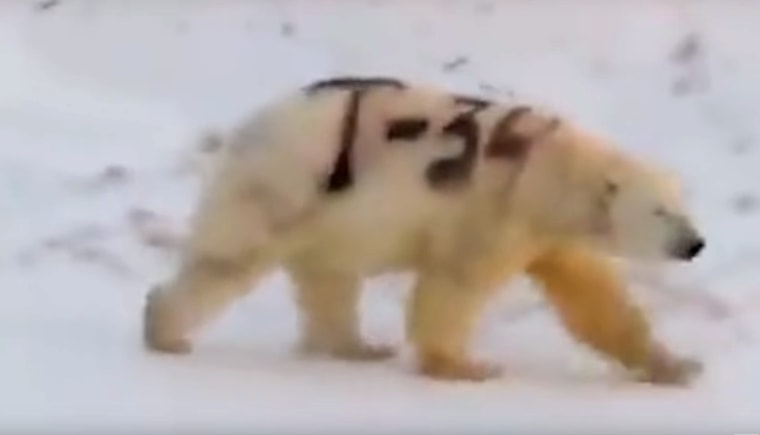Video footage of a polar bear lumbering across a snowy Russian expanse with big, black lettering spray-painted on its flank has sparked concern after it spread on social media.
But experts say that whether the graffiti is the result of scientific research or a prank, there’s likely no cause for concern for the individual polar bear.
The video, which shows the polar bear with “T-34” spray-painted on its side, was posted on Facebook by Sergey Kavry, who is part of a World Wildlife Fund-supported polar bear patrol group in the village of Chukotka, in Russia’s Far East region. The footage was met with outcry, with some concerned that the markings might put the animal at risk in the wild or prevent it from blending into its snowy environment.
In a statement provided to NBC News, the WWF said it was “surprised” to learn about the spray-painted bear in Russia, but added, “our polar bear experts do not believe there will be any long-term harm to the animal as a result.”
Kavry told the BBC that he did not capture the video himself and doesn’t know where or when it was taken, but said it had been shared on WhatsApp by residents of the Chukotka region.
Though T-34 is a type of Soviet-era tank that was used during World War II, it’s not clear what the lettering on the polar bear refers to.
"If it's a military lettering theme ... that is some kind of perverse disrespect for history,” Kavry told the BBC.
But Geoff York, the senior director of conservation at Polar Bears International, a nonprofit conservation organization headquartered in Bozeman, Montana, said he has been in touch with Russian scientists in the region who think the bear may have been marked for research purposes.
“Polar bears are routinely marked by research teams in order to remotely identify them individually and as previously captured,” he said, adding that this is required by regulation in the United States.
However, polar bears are facing real risks from climate change, as rising global temperatures and melting ice continue to alter their habitats. Polar bears are classified as “vulnerable” on the International Union for the Conservation of Nature’s Red List of Threatened Species. According to the IUCN, polar bear populations around the world could fall by more than 30 percent by 2050.
In addition to allowing researchers to keep track of the bears to avoid recapturing the same animals, markings can also indicate to indigenous hunters which bears have been handled recently to alleviate any food safety concerns.
York said he is not sure what is standard practice in Russia, but in the U.S., researchers use a commercially available, nontoxic hair dye to mark polar bears.
The black paint “generally wears off in 3-4 weeks time with no real danger to the bear,” Leanne Clare, a spokesperson for the WWF Arctic Programme, told NBC News in an email.
Yet, even if the “T-34” marking was not part of a research initiative and was instead done as a prank, experts say there is likely no additional risk to the animal and the paint should disappear once the animal sheds its fur.
Ian Stirling, a retired wildlife biologist who spent five decades studying polar bears in the Canadian Arctic, called the markings “silly and unsightly” but said they “will be gone at the next molt in about next May or June.”

